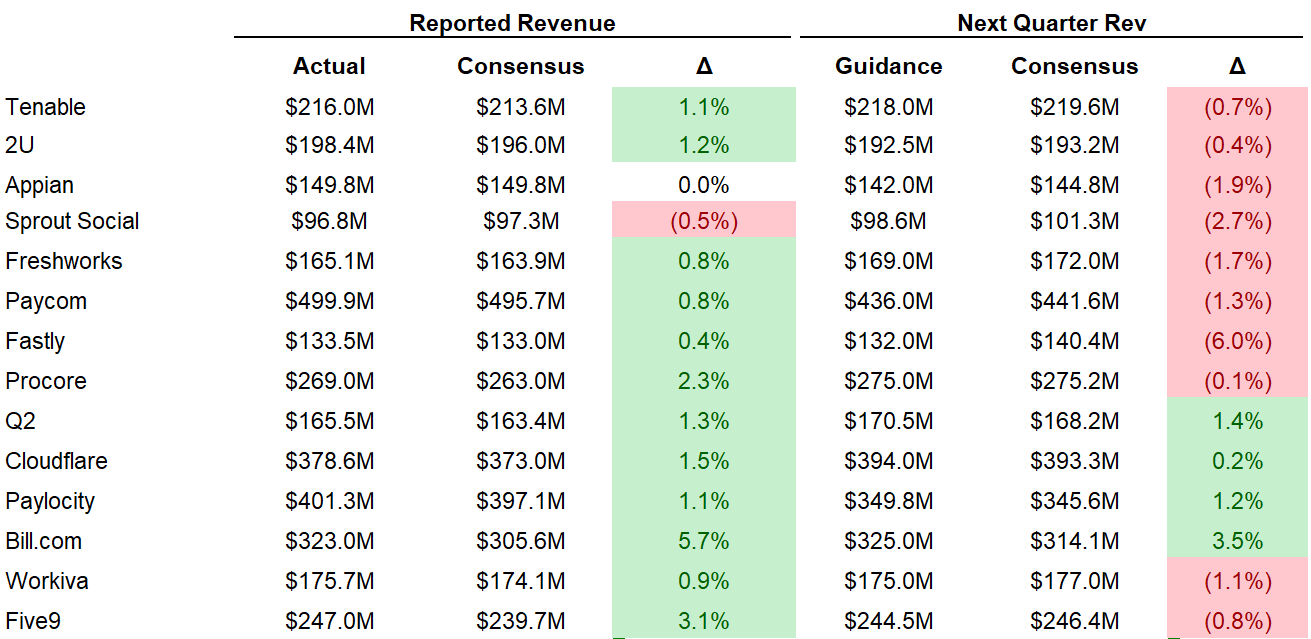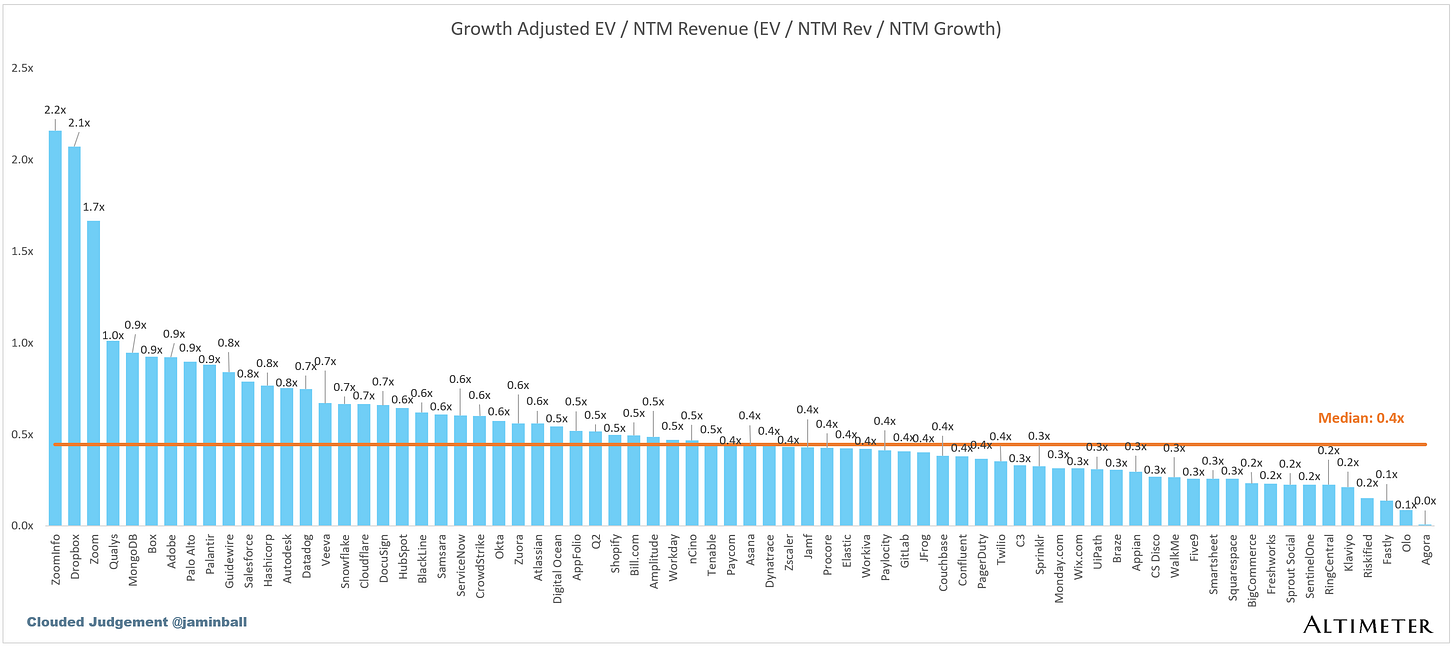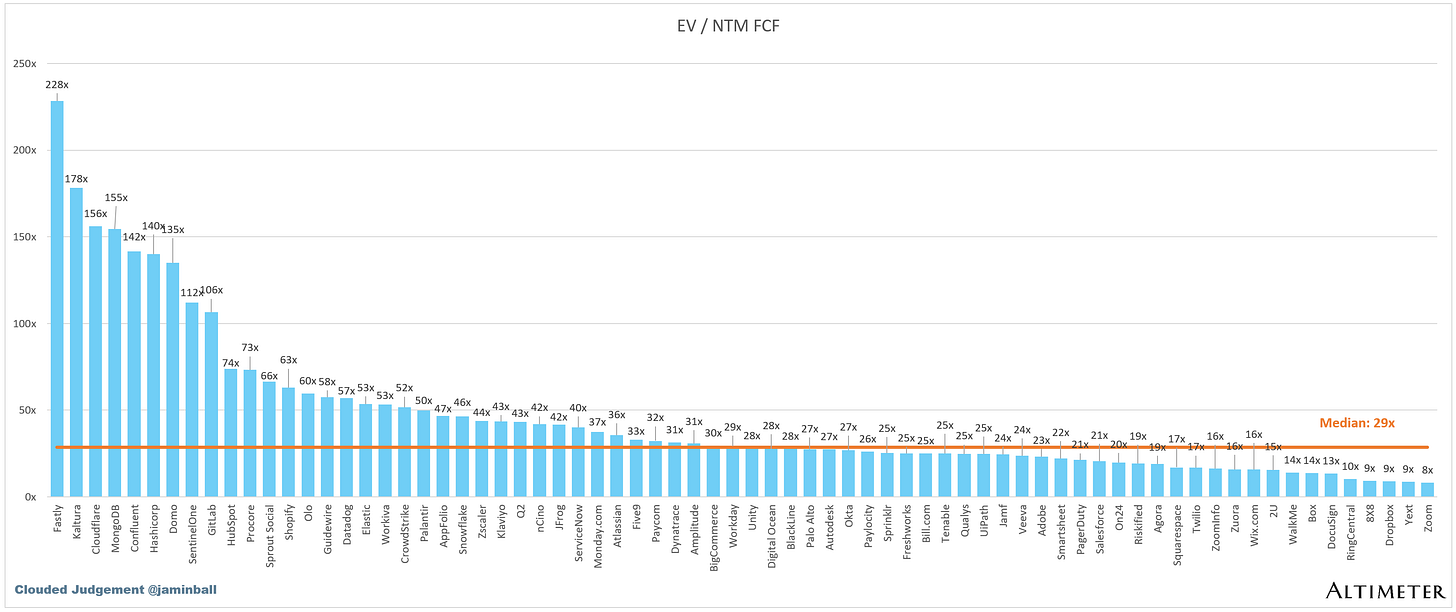Every week I’ll provide updates on the latest trends in cloud software companies. Follow along to stay up to date!
Cloud Giants Report Q1 + Early Look at Software Results
Q1 earnings seasons has officially kicked off! We now have results from the three hypersclaers (AWS / Azure / GCP). Summary of results below:
AWS (Amazon): $100B run rate growing 17% YoY (last Q grew 13%)
Azure (Microsoft): ~$76B run rate (estimate) growing 31% YoY (last Q grew 28%)
Google Cloud (includes GSuite): $38B run rate growing 28% YoY (last Q grew 26%, neither are cc)
Things are really starting to rebound for the major cloud providers. The most notable change in tone was Andy Jassy talking about AWS. His tone on the call really shifted from “things aren’t getting worse” (which was the tone of the last few quarters) to “things really started to get better.” Full quote below:
“We're seeing a few trends right now. First, companies have largely completed the lion's share of their cost optimization and turned their attention to newer initiatives. Before the pandemic, companies were marching to modernize their infrastructure, moving from on-premises infrastructure to the cloud to save money, innovated at a more rapid rate, and to drive more developer productivity. The pandemic and uncertain economy that followed distracted from that momentum, but it's picking up again. Companies are pursuing this relatively low-hanging fruit in modernizing their infrastructure.”
Unfortunately, the picture for the rest of the software universe is not so pretty…So far, 10 out of 15 (66%) of software companies who provided guidance for Q2 guided below consensus! This is lower than Q1 2020 (right at the onset of Covid) when everyone seemed to guide lower given the unknowns of Covid. Excluding that quarter, the next worst quarter saw ~56% of companies guide one quarter out lower than consensus. So we’re really off to a terrible start. Add to that, full year guides either were held constant or lowered (with the exception of Appfolio who raised full year guide by 1.3%. We’ve already had ~20% of software companies report Q1. And if the first 20% is any indication of what’s to come, it’s a sign that Q1 will not be a catalyst for forward estimates going up. Of course, it could also just be a bad sample set. After next week we’ll be through about half of the quarterly reports and should be able to draw more conclusions with a larger sample set.
Quarterly Reports Summary
Top 10 EV / NTM Revenue Multiples
Top 10 Weekly Share Price Movement
Update on Multiples
SaaS businesses are generally valued on a multiple of their revenue - in most cases the projected revenue for the next 12 months. Revenue multiples are a shorthand valuation framework. Given most software companies are not profitable, or not generating meaningful FCF, it’s the only metric to compare the entire industry against. Even a DCF is riddled with long term assumptions. The promise of SaaS is that growth in the early years leads to profits in the mature years. Multiples shown below are calculated by taking the Enterprise Value (market cap + debt - cash) / NTM revenue.
Overall Stats:
Overall Median: 5.8x
Top 5 Median: 17.5x
10Y: 4.6%
Bucketed by Growth. In the buckets below I consider high growth >27% projected NTM growth (I had to update this, as there’s only 1 company projected to grow >30% after this quarter’s earnings), mid growth 15%-27% and low growth <15%
High Growth Median: 8.7x
Mid Growth Median: 8.0x
Low Growth Median: 4.4x
EV / NTM Rev / NTM Growth
The below chart shows the EV / NTM revenue multiple divided by NTM consensus growth expectations. So a company trading at 20x NTM revenue that is projected to grow 100% would be trading at 0.2x. The goal of this graph is to show how relatively cheap / expensive each stock is relative to their growth expectations
EV / NTM FCF
The line chart shows the median of all companies with a FCF multiple >0x and <100x. I created this subset to show companies where FCF is a relevant valuation metric.
Companies with negative NTM FCF are not listed on the char
Scatter Plot of EV / NTM Rev Multiple vs NTM Rev Growth
How correlated is growth to valuation multiple?
Operating Metrics
Median NTM growth rate: 13%
Median LTM growth rate: 17%
Median Gross Margin: 75%
Median Operating Margin (11%)
Median FCF Margin: 11%
Median Net Retention: 110%
Median CAC Payback: 39 months
Median S&M % Revenue: 41%
Median R&D % Revenue: 25%
Median G&A % Revenue: 16%
Comps Output
Rule of 40 shows rev growth + FCF margin (both LTM and NTM for growth + margins). FCF calculated as Cash Flow from Operations - Capital Expenditures
GM Adjusted Payback is calculated as: (Previous Q S&M) / (Net New ARR in Q x Gross Margin) x 12 . It shows the number of months it takes for a SaaS business to payback their fully burdened CAC on a gross profit basis. Most public companies don’t report net new ARR, so I’m taking an implied ARR metric (quarterly subscription revenue x 4). Net new ARR is simply the ARR of the current quarter, minus the ARR of the previous quarter. Companies that do not disclose subscription rev have been left out of the analysis and are listed as NA.
Sources used in this post include Bloomberg, Pitchbook and company filings
The information presented in this newsletter is the opinion of the author and does not necessarily reflect the view of any other person or entity, including Altimeter Capital Management, LP ("Altimeter"). The information provided is believed to be from reliable sources but no liability is accepted for any inaccuracies. This is for information purposes and should not be construed as an investment recommendation. Past performance is no guarantee of future performance. Altimeter is an investment adviser registered with the U.S. Securities and Exchange Commission. Registration does not imply a certain level of skill or training.
This post and the information presented are intended for informational purposes only. The views expressed herein are the author’s alone and do not constitute an offer to sell, or a recommendation to purchase, or a solicitation of an offer to buy, any security, nor a recommendation for any investment product or service. While certain information contained herein has been obtained from sources believed to be reliable, neither the author nor any of his employers or their affiliates have independently verified this information, and its accuracy and completeness cannot be guaranteed. Accordingly, no representation or warranty, express or implied, is made as to, and no reliance should be placed on, the fairness, accuracy, timeliness or completeness of this information. The author and all employers and their affiliated persons assume no liability for this information and no obligation to update the information or analysis contained herein in the future.



















Thanks for taking the time and trouble to put this together. Great information...
Thanks, why does the "Quarterly Reports Summary" exclude other software names that have reported so far?